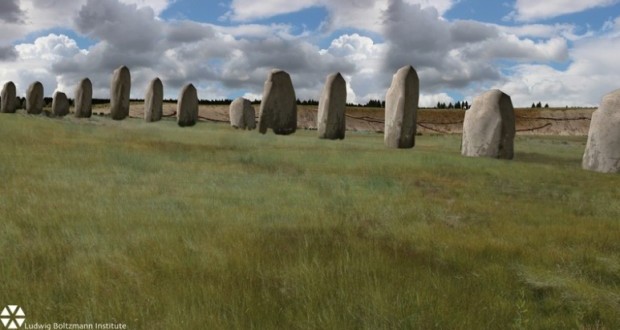An enormous row of 90 megalithic stones has been found buried beneath the prehistoric super-henge of Durrington Walls earthworks, only one mile from the world-famous site of Stonehenge in Wiltshire, England.
Built about 4,500 years ago, the stones lined an arena that was probably used for religious ceremonies or solstice rituals.
Using ground-penetrating radar on Salisbury Plain, scientists been found the stones lying on their sides and buried under three feet of earth.
Some of the stones are nearly 4.5m and were originally placed along the south-eastern edge of the circular enclosure that measured nearly a mile wide – making it the largest earthwork of its kind in the country.
The stones may not always have been part of the henge, possibly being toppled over before being incorporated into it – not an act of vandalism but an attempt to save whatever was thought to be important about the stone, experts think.
Professor Vince Gaffney, from the University of Bradford, said the ‘truly remarkable’ find is the most important to emerge so far from the Hidden Landscapes project which is mapping previously unknown archaeological features buried in the Wiltshire countryside.
Mr Gaffney, who is one of those leading the project, said: ‘We’re looking at one of the largest stone monuments in Europe and it has been under our noses for something like 4,000 years.
‘We don’t think there’s anything quite like this anywhere else in the world.
‘This is completely new and the scale is extraordinary.’
He said that such monuments were designed to ‘impress and impose’ and ‘to give the idea of authority to the living and the dead’.
Dr Nick Snashall, National Trust archaeologist for the Avebury and Stonehenge World Heritage Site, said: ‘These latest results have produced tantalising evidence of what lies beneath the ancient earthworks at Durrington Walls.
‘The presence of what appear to be stones, surrounding the site of one of the largest Neolithic settlements in Europe adds a whole new chapter to the Stonehenge story.’
Agencies/Canadajournal
 Canada Journal – News of the World Articles and videos to bring you the biggest Canadian news stories from across the country every day
Canada Journal – News of the World Articles and videos to bring you the biggest Canadian news stories from across the country every day



